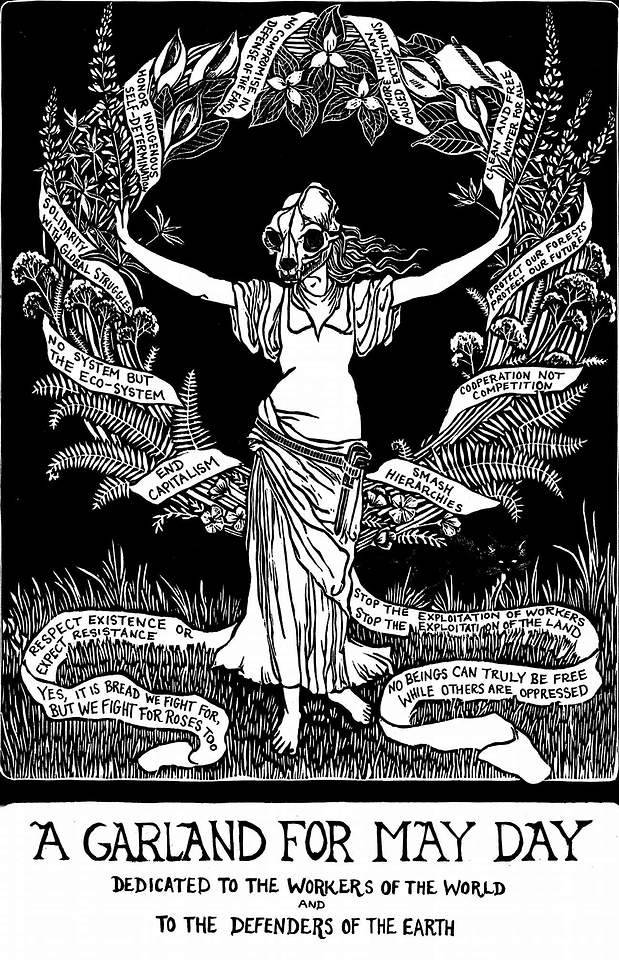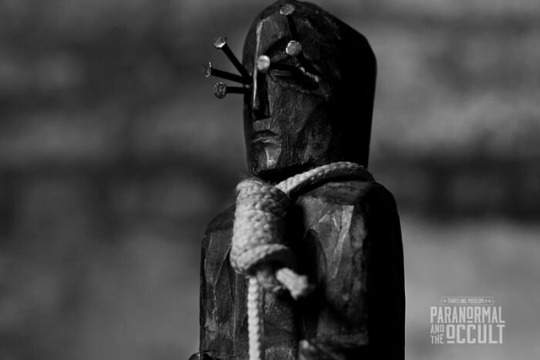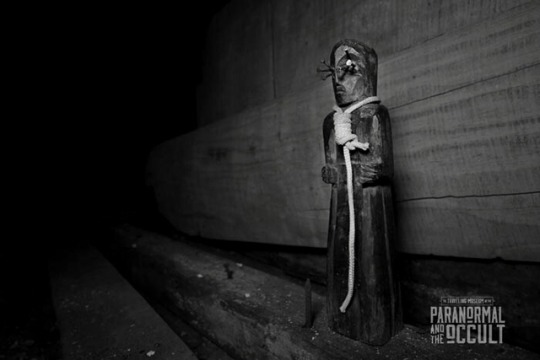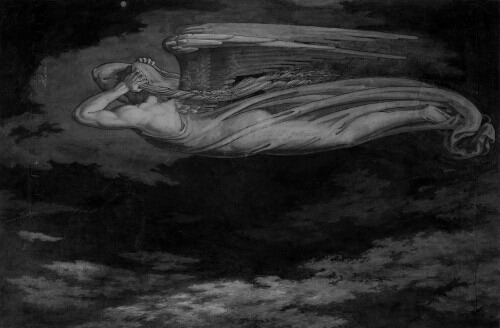Quote
“Since the demons aren’t summoned anymore,
They are coming by themselves.”
Müller-Sternberg, P.9
1K notes
·
View notes
Photo

Art by Entangled Roots Press.
1K notes
·
View notes
Text
Lasciate ogne speranza, voi ch'intrate.
56 notes
·
View notes
Text
The Ruinous Rod of Blasting
Throughout time, the wand, staff, and scepter have become a part of the magician’s image. As kings held a scepter to symbolize their power, so a magician would hold a rod to symbolize their own. This symbol has existed from the ancient days of Moses into modern times where we have Harry Potter.
There were different kinds of wands owned and employed by sorcerers over the years, but none so terrible and harrowing as the blasting rod. This mystical stick could cause destruction in both the spirit world and mortal world alike. Because of that, both spirit and human feared this tool in the hands of magicians.
Just as many other magical tools, it can be found in both ceremonial magic and folk magic. However, unlike other tools, this is one that has two different interpretations for the two sections of magic. Both are used for ‘blasting’ and damning, but the methods of use and creation are different. It it originated with one or the other, simply that is a tool of magic useful to both folk magicians and ceremonial magicians.
Most of the time, when someone hears ‘blasting rod’, they hear it in the context of low magic. Blasting was something done by witches and cunning folk as a method of sharp, acute cursing. It caused illness, blights, storms, impotence, sterility, barrenness, and misfortune. One of the most common methods of blasting was when a witch would employ their trusty blackthorn rod. The stick was pointed, tapped, and shaken at its intended victims. In some lore, the same rod that placed the curse would be able to undo it. Witches with crooked blackthorn canes are the image tied to this lore. Blackthorn is the most commonly used wood for a blasting rod, so much so that the term has become semi-synonymous with ‘the blackthorn stick’. The thorns of the blackthorn are sharp and cause infection. It was thought to also take revenge on humans that cut it. Just as with other faery trees, the blackthorn was harnessed by witches and magicians as a tool of power. Though blackthorn is the traditional wood for a blasting rod, other thorny branches have been known to be used for it. I’ve seen sticks of blackberry, locust, and even old rose bush branches being employed for similar purposes. The thorns are sometimes left along the stick, and sometimes are taken off and fixed on the end. Sometimes a combination of the two is used. The rod is usually longer than other wands, but shorter than most staffs, making it just the right length for a cane.
In ceremonial arts, the blasting rod differs in creation and methods, but its purpose remains similar to the one used in folk magic. The blasting rod used in ceremonial magic serves a similar purpose to a black handled knife. It is used to command, compel, and threaten spirits or demons. The Grand Grimoire gives both uses and directions to make such a rod. The ritual process of making the rod is arduous, but the requirements of the wand are quite clear. Unlike the folk magic variant, a ceremonial blasting rod is to be made from a forked branch of wild hazel, measuring 19 1/2″ long. The tree it is to be cut from must have never borne fruit. The sharpened tips of the fork are capped with steel from a blade used to make a sacrifice and magnetized with a lodestone. When used in ritual, if the magician wishes to smite a spirit for noncompliance, the forked prongs are held over a flame while uttering a curse to the spirits. The Grimoire claims that this tool has come directly from God, as He used it to smite traitorous angels and throw them down. The Grimoire also accounts for its power over storms and its ability to both call them down and push them away.
Whether it be bloodied steel or piercing thorn, the blasting rod not only sends forth attacks, but it also protects the magician. It is, of course, offense which serves as the best defense. The rod can be used to place protection curses (I swear, it’s not an oxymoron) on places, people, and things. Should the protection spell be broken or compromised, the curse is activated and attacks the attacker. The rod itself might be charmed to spectrally attack those who seek to harm its owner, whether spirit or living being. In ceremonial magic, the blasting rod can be used as retaliation against a spirit or demon who seeks harm on the magician. In folk magic, the blasting rod might be used to blast someone who wishes ill on the magician. In addition, just as the blackthorn has the power to conjure frightful storms, it also has the power to wash them away. Though defense and offense are thought to be opposites, they are the same face wearing different masks.
I have no doubt that the blasting rod as described in the Grand Grimoire could also be employed as the thorny variation. A forked branch, capped with steel used to make a sacrifice, magnetized with lodestone, could very well prove to make nasty curses on the living, especially so in keeping mind of the damage it causes to spirits.
It is also interesting that the rod is tethered to the powers of lightning and storms. I suppose this keeps in line with its title and primary use. Lightning blasts things. It is quick, but it can cause untold destruction. Just as a single thorn prick can cause terrible infection (especially so for blackthorn), a single lightning strike can light the forest ablaze. As for the ceremonial one, God is known for striking and speaking through lightning and storms. His wrath is often thought to be called down through the sky. The blasting rod is His tool, according the to Grand Grimoire, so why would it not exemplify his ire and fury?
The blasting rod is a true symbol of the terrible power that magicians hold over the world, as in direct symmetry with the power that God does. Both spirits and townsfolk remember that power.
1K notes
·
View notes
Quote
All religions and all sciences connect themselves with one single science, always hidden from the common herd, and transmitted from age to age, from initiate to initiate, beneath the veil of fables and symbols. It preserves for a world yet to come the secrets of a world that has passed away.
Eliphas Levi
395 notes
·
View notes
Text
The Night is the Devil’s Black Book, wherein he recordeth all our Transgressions.
134 notes
·
View notes
Photo

From The Black Toad by Gemma Gary.
#Gemma Gary#The Black Toad#Charm Box#Power and Preparation#Cornish Witchcraft#Traditional Witchcraft#Witchcraft#Applied Witchcraft
613 notes
·
View notes
Quote
But to prove this my first proposition, that there can be such a thing as witchcraft, and witches, there are many more places in the Scriptures than this (as I said before). As first in the law of God, it is plainly prohibited: (Exod. 22.) But certain it is, that the Law of God speaks nothing in vain, neither does it lay curses, or enjoin punishments upon shadows, condemning that to be ill, which is not in essence or being as we call it.
Epistemon; Daemonologie, by King James, c.1597.
52 notes
·
View notes
Photo

6K notes
·
View notes
Text
The Oracle of Hekate Denounces the Divinity of Jesus Christ
The Neoplatonist Porphyry of Tyre (c. AD 234 – c. AD 305) once consulted an oracle of Hekate concerning Jesus. Here follows the text of the oracle of Hekate concerning Jesus, as well as Porphyry’s interpretation as it appeared in the "Philosophy of Oracles," which is now lost to history. Theodosius II burned all works of Porphyry in 435 and 448 AD. But to some who asked Hekate whether Christ were a God, she replied: “You know the condition of the disembodied immortal soul, and that if it has been severed from wisdom it always errs. The soul you refer to is that of a man foremost in piety: they worship it because they mistake the truth.” To this so-called oracular response he [Porphyry] adds the following words of his own: “Of this very pious man, then, Hekate said that the soul, like the souls of other good men, was after death dowered with immortality, and that the Christians through ignorance worship it. And to those who ask why he was condemned to die, the oracle of the goddess replied, “The body, indeed, is always exposed to torments, but the souls of the pious abide in heaven. And the soul you inquire about has been the fatal cause of error to other souls which were not fated to receive the gifts of the gods, and to have the knowledge of immortal Zeus. Such souls are therefore hated by the gods; for they who were fated not to receive the gifts of the gods, and not to know God, were fated to be involved in error by means of him you speak of. He himself, however, was good, and heaven has been opened to him as to other good men. You are not, then, to speak evil of him, but to pity the folly of men: and through him men’s danger is imminent.”
395 notes
·
View notes
Photo


The Crone of the Catskills “As the days went on, the statue appeared to move around the home seemingly of its own accord, muddy footprints began to manifest on the floor, and the pungent scent of stagnant pond water filled the house. On the seventh day, they saw her crouched in the shadows of the living room: The Crone, a horrifying apparition with an emaciated body and eyes that shined in the darkness.”
#The Crone of the Catskills#The Traveling Museum of the Paranormal and the Occult#Paramuseum#Night Hag#Spectral Hag#Spectral Attack#Mare#Mære#Mere#Effigy#Malefic Witchcraft#Witchcraft#Applied Witchcraft
178 notes
·
View notes
Quote
In 1770, British parliament banned lipstick, saying it had the power to seduce men into marriage, which was classified as witchcraft.
(via rosestarred)
3K notes
·
View notes
Photo

Index of First Lines | Emily Dickinson: The Complete Poems
30K notes
·
View notes
Text
Use of Spectral Evidence in the Salem Witch Trials
"Spectral evidence" is a form of evidence based upon dreams and visions. It was admitted into court during the Salem Witch Trials by the appointed chief justice, William Stoughton. The booklet A Tryal of Witches, taken from a contemporary report of the proceedings of the Bury St. Edmunds witch trial of 1662, became a model for and was referenced in the Trials when the magistrates were looking for proof that such evidence could be used in a court of law. Spectral evidence was testimony that the accused witch's spirit, called a spectre, appeared to the witness in a dream or vision, sometimes as they would appear normally, other times as a foul hag, a swarm of insects, or a black cat or wolf. Thus, witnesses and accusers would testify that "Goody Proctor bit, pinched, and almost choked me," and it would be taken as evidence that the accused were responsible for the biting, pinching and choking; even though they were elsewhere at the time. Thomas Brattle, a merchant of Salem, made note that "when the afflicted do mean and intend only the appearance and shape of such an one, say G. Proctor, yet they positively swear that G. Proctor did afflict them; and they were allowed to do so; as though there was no real difference between G. Proctor and the shape of G. Proctor." Reverend Cotton Mather argued that it was appropriate to admit spectral evidence into legal proceedings, but cautioned that convictions should not be based on spectral evidence alone, as it was possible for the Devil to take the shape of an innocent person.
#Spectral Evidence#Spectral Attack#Spectre#Spectral Hag#Hag Riding#Mare#Mere#Mære#Nightmare#The Night Hag#Salem Witch Trials#Persecution#Witchcraft
99 notes
·
View notes
Photo

The Night Hag, by Henry Fuseli, 1741-1858.
#The Night Hag#Henry Fuseli#Mare#Mere#Mære#Spectral Hag#Spectral Attack#Spectre#Hag Riding#Witchcraft
247 notes
·
View notes

